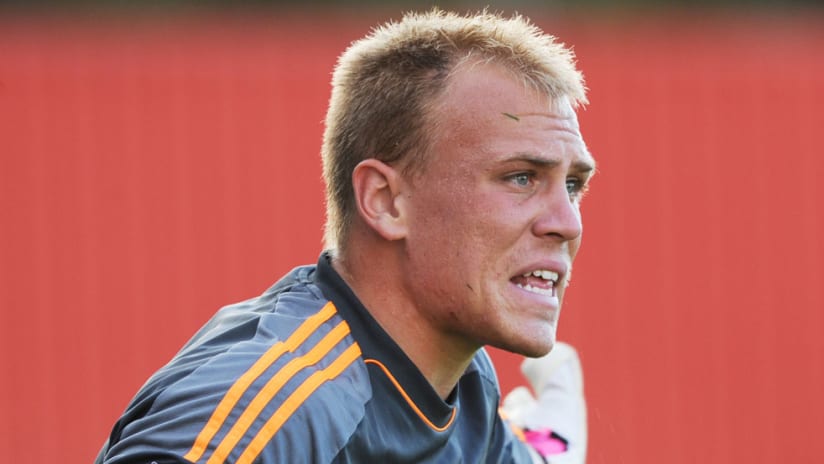Experienced US youth international goalkeeper and occasional USMNT camp invitee Cody Cropper signed what his agent said was a multi-year deal with New England on Thursday, joining the Revs a couple of months after he was released by English club MK Dons.
The move was curious for a couple of reasons. First was that Cropper landed in MLS but didn’t sign with incoming expansion sides Minnesota, where he was born, or Atlanta, where he moved around the start of his teenage years. He even said in March that “there are really only two teams I have a desire to play for – Minnesota United and Atlanta United” and spent three months this year with Minnesota rehabbing his shoulder following minor surgery.
Second was the fact that Cropper was signed through the discovery process and not the allocation ranking list, a mechanism that other, less experienced US youth internationals have gone through in past years.
According to the MLS roster rules, the allocation ranking list consists of select USMNT players, elite youth US national team players or former MLS players returning to MLS after joining a non-MLS club for a transfer fee greater than $500,000.
Cropper, who backstopped the US at the 2013 Under-20 World Cup, appeared for the U-23s in the first leg of the Olympic qualifying playoff in March and has spent time in full USMNT camp, could certainly be considered an “elite” US youth international. He has more youth national team experience than other players who have been acquired through the allocation mechanism, including San Jose’s Marc Pelosi, who was brought back via the allocation last year.
Cropper’s agent, Chris Megaloudis, told MLSsoccer.com on Thursday that he hadn’t yet been told why Cropper was a discovery signing and not an allocation player. According to the rules, players on the Allocation Ranking List are determined by MLS's player personnel department and club technical staffs. The list is updated once each year, during the time window between the end of the MLS regular season and MLS Cup.
That Cropper went through the discovery process was what ultimately landed him in New England. According to Megaloudis, the Revolution held Cropper’s discovery rights for a significant stretch of time, giving them the right of first refusal among MLS teams to sign him.

Megaloudis said that he learned of New England’s discovery claim on Cropper after first talking with another MLS team about the 23-year-old goalkeeper, then entered into discussions with the Revs, who were determined to sign Cropper and not trade his rights to another team.
Cropper was close to taking what Megaloudis called a “short-term offer” from the NASL’s Jacksonville Armada, but the club's interest dissipated after former US national team goalkeeper Tony Meola was dismissed as head coach last week. Cropper also had standing invitations to go on trial with several teams in the English Championship, as well as some interest from a pair of Scottish Premier League clubs, but was drawn to New England in part because of their willingness to sign him without a trial.
Cropper will now likely compete with Brad Knighton for the Revs’ backup spot behind starter Bobby Shuttleworth. He’ll undoubtedly eye a more significant role for 2017, either with New England or with a different club, potentially one that could select him in the upcoming expansion draft.
Toronto’s strange Cooper saga comes to a close

Cropper’s move wasn’t the only curious transaction that went down on Thursday.
Toronto FC finally completed the acquisition of Panama national team midfielder Armando Cooper yesterday, announcing the signing of the 28-year-old midfielder on loan from Arabe Unido nearly two weeks after MLS’s secondary transfer window closed on Aug. 3.
TFC GM Tim Bezbatchenko told MLSsoccer.com over the phone on Thursday that the loan will run through the end of the season, with Toronto holding an option to buy Cooper outright when the deal ends.
Landing Cooper is a solid pickup for TFC, who gain an experienced, versatile midfielder in the prime of his career for the stretch run. Had the move been announced a couple of weeks ago, there wouldn’t be much intrigue here. But the 15-day gap between Thursday’s news and the transfer deadline begs the question: What was the hold up?
The answer is a bit complicated.
Any transfer or loan deal must be recorded through FIFA’s online transfer matching system. Both participating clubs are required to enter matching details of the transaction – in this case, the terms of the loan agreement – into the system before the close of the transfer window. Once approved, the national federation of the club the player is moving to can request the player’s international transfer certificate (ITC) from the federation he’s leaving.
Bezbatchenko said that Toronto and Arabe Unido had agreed to the loan and that Cooper, TFC and MLS – which owns the contracts of every player in the league – had a contract set well before the close of the window. He added that TFC entered all the required information into the transfer matching system prior to the close of the window and that Arabe Unido claimed to have done the same, but that the transfer matching system didn’t confirm that the deal had gone through.
“Essentially it’s like a wire transfer in a bank. You put in the numbers, then you press the button,” Bezbatchenko said. “Well everyone pressed the button here, but it wasn’t showing up as being received. I think that’s sort of the best way to put it. I wasn’t in Panama, I can’t see when they pressed the button but obviously they believe there might have been technical issues on their end.
“On the system, it was not allowing the final word. Everyone was looking for that word complete to pop up, for ITC received to show, and that never came up.”
Bezbatchenko wasn’t entirely sure if the snafu was caused by a technical glitch or a timing error on the part of Arabe Unido, who may have thought they had until 12:59 am ET on Aug. 4 to complete the deal. The window for MLS’s Canadian teams actually closed an hour earlier, at 11:59 pm ET on Aug. 3.
Because U.S. Soccer’s headquarters are located in Chicago in the Central Time Zone, the transfer window for MLS’s American clubs stays open until 12:59 am ET. The window for the league’s three Canadian teams shuts an hour earlier, as the Canadian Soccer Association’s headquarters are in Toronto, which is on Eastern Time. The time zones are relevant because ITCs are requested by national federations, not clubs.
Regardless of what caused the glitch, it forced both clubs, the CSA and the Panamanian federation to lodge an appeal with FIFA to push the transfer through. They had to collect evidence and submit it to FIFA’s player movement committee, which ruled earlier this week that the loan could go through, allowing Toronto to announce the move on Thursday.
Cooper will now be eligible to play for TFC as soon as he receives his Canadian work permit, giving the club what Bezbatchenko hopes will be a valuable piece as they look to win the Eastern Conference regular season title and move into the playoffs.
Ebobisse acquisition explained
As first reported by Steve Goff earlier this week, US Under-20 and former Duke University forward Jeremy Ebobisse has signed with the league and will be available for selection in next year’s SuperDraft.
Ebobisse withdrew from Duke after his sophomore season in 2015 and trained with several clubs in Europe prior to signing a deal with MLS earlier this week. According to Goff, Ebobisse, who grew up in Maryland, will train with D.C. United or USL club Richmond Kickers for the rest of the year before going into the draft in January.
After news of his signing broke, there was a bit of confusion as to why Ebobisse had to wait until January to be acquired by an MLS team. In the past, Ebobisse would’ve joined the league via a weighted lottery, which allocated players through a lottery system that gave the lottery entrant club with the worst record the best chance of acquiring the player in question.
However, MLS has eliminated the lottery system. A league spokesperson confirmed on Friday that the lottery was eliminated as a player acquisition mechanism in 2015, when it was folded into the revised allocation ranking order.
Like Cropper, Ebobisse wasn’t on the league’s allocation ranking list. He also wasn’t able to be signed through the discovery process, as the league roster rules bar clubs from adding players to their discovery lists that, like Ebobisse, “played at college or forwent college during the college season immediately prior to the date of discovery.”
With those options off the table, the lottery eliminated and Ebobisse ineligible to sign a Homegrown deal, the SuperDraft was the only way that Ebobisse could enter the league.
Penn talks up LAFC stadium

LAFC announced a major step on the way to their 2018 launch on Friday, when they revealed that they’ll hold a groundbreaking event for their new downtown stadium on Tuesday.
The stadium is expected to seat 22,000 and will be located next to the Los Angeles Memorial Coliseum on the site of the LA Sports Arena. I spoke with LAFC president and part-owner Tom Penn earlier this year for a separate story and he touched on a few proposed details of the stadium, noting that it was designed with the idea of making it as loud as possible.
“Because it’s in an urban setting we want to have it be an intense, on top of the action experience,” Penn said. “So we challenged our architects to build in, over and up rather than sprawling and out where the energy dissipates. So from the grade of the seats, the pitch of the bowl, the roof lines and the way they swoop in and the way they hold the noise in, that’s all purposefully designed. Even the exterior of the building, the whole exterior of the building leans in on the action so all the energy and all the focus will be on the pitch.
“We’re building a supporters’ section like no other in North America in terms of its size and its amenities. It’s a dedicated north end. It’s very steep with a supporters’ club at the top of it and a sky deck atop of it for standing room only for sort of a thunderdome-type atmosphere as it cantilevers back toward the action.”
You can check out the latest renderings of the stadium here.













